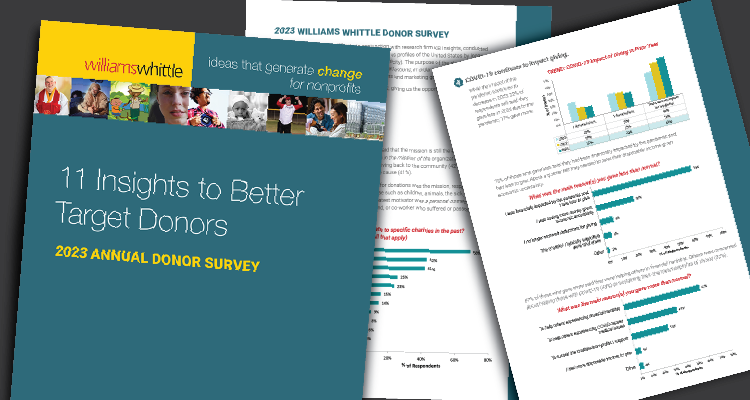In February 2023, Williams Whittle, in conjunction with research firm KB Insights, conducted a national survey of U.S. adults mirroring the census profiles of the United States by location and demographics (e.g., gender, age, income, ethnicity). The purpose of the study was to understand past and future donor behaviors and intentions, in order to provide insight and guidance to nonprofits to improve communications and marketing going forward.
Similar studies were conducted in 2020 and 2022, giving us the opportunity to view how trends have shifted over the last three years.
- The mission is the motivator.
Consistent with prior years, the driving force behind donations is the mission. Believing in the mission of the organization was identified by 68% of respondents, followed by giving back to the community (42%) and a personal connection to the cause (41%). Of the respondents who selected the mission, they referenced addressing a particular need and/or cause such as children, animals and veterans. Those that selected personal connection did so because of a family member, friend or co-worker affected by illness or disease.
- Individual success stories make the biggest impression.
When it comes to receiving updates from nonprofits and charities they regularly support, donors prefer information about those participating and benefiting from the program. Storytelling resonates with donors; almost twice as many connect with personal stories than group stories or stats/charts/graphs showing the overall impact of donations.
- Donors are giving more money, yet supporting fewer charities.
Median annual giving is consistent with 2022 findings at $251-$500. Large donations ($1,000+) have rebounded slightly compared to prior years; however, very large donations ($5,000+) have continued in a downward trend. Donors are supporting fewer charities than they did in previous years. 81% of 2023 respondents reported supporting between 1 and 5 charities, up from 69% in 2020.
- COVID-19 continues to impact giving.
The impacts of the pandemic continue to decrease in 2023, however, 22% of respondents still said they gave less in 2022 due to the pandemic; 17% gave more. Of those who gave less, 70% reported they were financially impacted by the pandemic and had less to give and 26% felt they need to save more money given economic uncertainty. Of those who gave more, 67% said they were helping others experiencing financial hardship, 43% were helping others experiencing COVID-19-related medical issues, and 32% were sustaining the charities/nonprofits of their choice.
- Donors are more open to supporting different charities in the future.
44% of respondents reported they are open to change in the nonprofits they will support in the future, a large increase from 2020 levels at 35%. This is both a positive for nonprofits seeking new donors and a negative for donor retention. When asked the types of organizations likely to support in the future, respondents answered poverty/human services, animal and health charities. Some causes such as education, health and the environment are on the rise from 2022.
- Most prefer to give to local charities.
When given local, state, national and global options for giving, the most common preference was local. This highlights the need for state, national and global charities to use a local angle in their campaigns.
- Email is the preferred communication method to stay in touch and solicit donations, but direct mail is still a player.
More than half of respondents (54%) said they prefer charities/nonprofits that keep in touch via email. Next came direct mail with 36%, followed by social media with 21%. The preference for text message communication increased slightly while newsletters and magazines, a mainstay of nonprofit communications, were preferred by a minority of respondents. When considering donations, the preferred communication methods are consistent with email, direct mail, and social media. However, the preference for phone calls has increased.
- Public service announcements continue to influence donations.
Given their usual broad reach, public service announcements (PSAs) often serve as an introduction to potential donors. 34% of respondents said they donated as a result of a PSA, up from 29% in 2022, demonstrating the influence they have in giving.
- A strong social media presence is a must. Instagram on the rise.
The average social media user spends 2-½ hours per day online and visits 7.2 different platforms a month. Nonprofits should solidify their presence across platforms to stay in front of current and future donors. Facebook was by far the most common platform on which respondents follow their favorite charities, followed by Instagram and YouTube. Today, 41% of U.S. adults who plan to donate in 2023 say they already follow nonprofits on social media.
- TV remains the #1 news source but online is close behind.
58% of respondents get their news by watching TV; however, news consumption online (49%) and via social media (33%) is catching up. Additionally, podcasts increased both as a news source, in addition to general usage. These increases offset declines in newspaper and magazine readership.
- Nonprofits must continually demonstrate tangible impact.
72% of respondents felt their contributions made an impact, slightly lower than last year. When asked how nonprofits demonstrated their impact, respondents referenced providing for community needs such as shelter, food, clothing, childcare, medical research and disaster relief.
Click here to view the full report.
Click here to read about the survey in Capitol Communicator.



